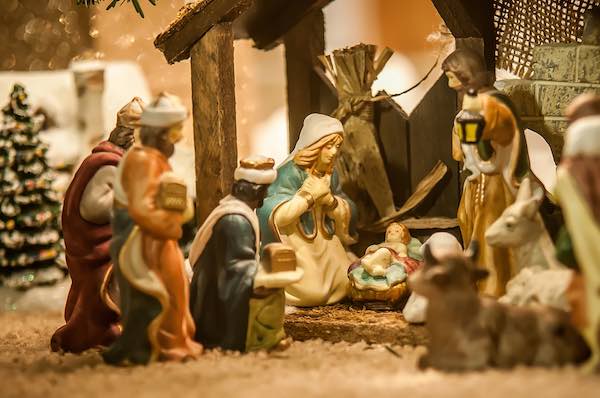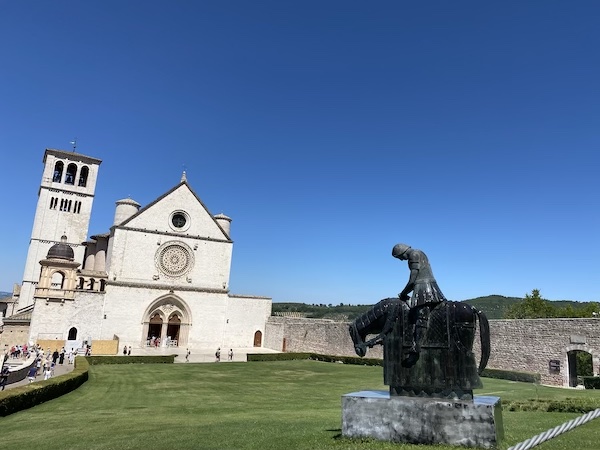
Presepe in Italy: all you need to know about Italian nativity scenes
Presepe in Italy: All you need to know about the Italian Christmas tradition of presepe, Italy’s nativity scenes. What presepe is, history of presepe, where to see the best nativity scenes in Italy.
There are many Christmas traditions in Italy; one of the most ancient and unique is the tradition of making a presepe.
Presepe (pronounced pre -seh-peh) is the Italian word for the nativity scene or Christmas crib.
Presepe (or presepi, plural) can be large or small, in a home or a public place, in a church or a piazza, but they all have something in common: they always have figurines of baby Jesus in the crib, Mary, Joseph, villagers, the Christmas star and the Three Kings!
The tradition of making presepe is very ancient and is rooted in the Christan tradition of the Nativity in Bethlehem and baby Jesus in a manger.
However, over the century, the representation of nativity has developed. Nowadays, you see nativity scenes in Italy in all shapes and forms: some traditional, some very much not traditional at all!
If you are in Italy in December, you will come across presepi no matter where you are.
In this article, we look at what an Italian presepe is, its main components, and where you see the best nativity scene in Italy.
We also touch on a very peculiar Italian nativity tradition: that of presepe vivente, aka a living nativity scene!
What is a presepe
Presepe is the Italian word for a nativity scene or Christmas crib.
According to linguists, the word presepe comes from the Latin praesepere, which translates as fenced place and recalls the idea of the manger surrounded by some sort of fencing or protection.
In Italian:
Presepe is singular, while its plural is presepi, so you would say:
Il presepe = the nativity scene
I presepi = the nativity scenes
Examples:
Oggi ho fatto il presepe = today I made the nativity scene
100 presepi = one hundred nativity scenes (a recurrent exhibition, more about it below).
In Neapolitan, you can also hear O presepe, an expression you can hear in the famous movie Natale a Casa Cupiello, an old traditional Italian movie with the great Neapolitan actor Eduardo de Filippo. Watch the scene here
Occasionally, you may also hear the word presepio, equivalent to the more widespread presepe, yet also correct.

What goes into a presepe in Italy
A presepe is a representation of the birth of Jesus, and has some elements that you find in all nativity scenes, no matter how traditional or modern they may be.
An Italian nativity scene must have the following:
Baby Jesus in a crib – this can be a traditional manger or any other frugal crib.
Depending on family traditions, infant Jesus can be in the manger from the day the presepe is set or you can see families adding it at midnight between the 24th and 25th of December.
Mary, usually represented kneeling beside the baby
Joseph, usually represented beside the crib with the tall, hooked baton of the Shepard
An ox and the donkey, to recall the tradition according to which they kept baby Jesus warm with their breath
A shooting star on top of the scene
Shepherds or villagers visiting the baby and acting like a chorus of onlookers.
The Three kings / The Three wise men / I Re Magi, as we call them in Italian.
Fun fact! According to the nativity story, the Three Kings got to see baby Jesus on the 6th of January, the day of the Epiphany (from Greek epi – phanos = to appear, to reveal oneself). Because of this, many people place the little statues of the Three Kings far away from the crib and have them get a little closer as the Epiphany approaches as if to mark their journey!)
Traditional Italian nativity scenes vs. modern nativity scenes
In the most conventional Italian scenes, the birth of Jesus is represented closely following the story told by the gospel.
In these presepi, the scene is usually set in a stable in a village or in a cave.
In this version, Mary and Joseph wear traditional clothes of the time and the villagers coming to see the baby are shepherds with long robes, shepherding batons and headpieces.
These traditional nativity scenes are very common and you see them in many settings around Italy. However, they are far from being the only type of representation you can find!
Since presepe is also a symbolic and metaphorical representation, you can see the scene of the nativity represented in many other ways.
Depending on where you are, you may find a presepe made of lego, an underwater one, one set in space, and you may see that among the people visiting the baby, there are not just shepherds but recognizable characters such as Queen Elisabeth!
The presence of these different figures in Italian nativity scenes is sometimes controversial.
However, the Vatican itself reinvents the nativity scene each year, to some extent, so while it is important to respect the religious meaning of the nativity scene, it is perfectly acceptable to apply some creativity to it.

A fantastic example of unusual tales on presepe is often found at the Vatican.
Each year, the Vatican’s nativity scenes revolve around a topic that the church wants to raise awareness about.
For example, the tragedy of people losing their lives in the Mediterranean while trying to escape poverty and war made the Vatican build a nativity scene in the shape of a ship. A wonderufl exmple of the flexibility of the presepe in temrs of hte message it sends.
If you are planning a holiday to Rome, you can read here >>> all about the Vatican at Christmas
Presepe vivente: Italy’s living nativity scenes
A very peculiar type of presepe you can see in Italy is the presepe vivente, the living crib!
Presepe vivente is not a static handmade nativity scene but a living representation with people dressed up and reenacting the nativity events.
Famous presepi viventi are in:
Greccio (Lazio) – Greccio is the town in Lazio where san Francis made the first presepe in history, starting a centuries-long tradition (see below).
The town still has one of the best presepi in Italy, which you can see on 24- 25-26- 28 December 2022 and 1-6-7 January 2023.
Matera (Basilicata) – The living crib in Matera is one of the most impressive in Italy, as it makes the most of the fascinating setting of the caves that are peculiar to the geography of this area.
Good to know You can see Italian nativity scenes in many locations in Italy. You can find official lists on this link: on the top menu, click on ‘presepi viventi in Italia’ and select the region you’ll be in to see a list of all those running this year with exact dates, locations and times!
When do Italians make presepe
In Italy, we usually make presepe on the 8th of December.
On the 8th of December, Itay celebrated the Catholic festivity of the immaculate conception: the day is a national holiday, and it is traditionally when families put up the Christmas tree and the presepe!
This is also the day when public Christmas trees and nativity scenes officially open to the public.

Where do Italians make presepe
You can see presepi in private and public spaces but there is no special rule about where they go.
In homes, presepi are in a visible corner of the house, often a table or a sideboard.
Occasionally, presepi can be close to the Christmas tree. However, the two traditions do not overlap and have little in common, so usually, the presepe has its own dedicated location.
Presepe in public places are usually in piazzas and churches; however, especially in Italian regions with a strong presepe tradition such as Campania, you can see them everywhere!
When we walked the path of lemons between Minori and Maiori, we saw a presepe in a little cave along the trail, and in Amalfi town, we saw a water one in a fountain!
There is no rule about where a presepe can or cannot be or how big or small it is!

Where to see presepe in Italy: unique best presepi in Italy
You can see presepi pretty much anywhere in Italy and since each scene is set up each year, you never know how each presepe is going to turn out and which ones will be the most extravagant and popular.
However, there are some places that are famous for usually having the best presepe in Italy! These are:
San Gregorio Armeno – as mentioned above, San Gregorio Armeno is the street in Naples where you find presepe artists. Rather than seeing one presepe here, you see the full arrays of presepe styles and figurines: a unique experience!
The Vatican – it will come as no surprise that one of the biggest and best nativity scenes is the one in the Vatican, in Rome.
The crib is set in the center of St Peter’s Square and it is made from scratch each year, with a different theme each season.
Manarola – The presepe of Manarola in Cinque Terre, is unique and holds the record as the biggest presepe in the world! The presepe takes up the whole hill over which Manarola develops and you see it best from the central square and, even better, from the trail between Manarola and Riomaggiore (if open).

The submerged presepe in Laveno – just what the name suggests, the presepe sommerso is an underwater presepe you can see in Laveno, in the province of Varese, on Lake Maggiore (Lombardy)
Sand presepe – a collection of presepi sculpted in the sand can this year be seen in Lignano Sabbiadoro (Friuli Venezia Giulia)
Floating presepe – several localities pay homage to their coastal locations with floating presepi! Among the most famous, that of Cesenatico and Comacchio (Emilia Romagna) and Crodo (Piedmont)
Ice presepe of Jesolo, the biggest of its kind in Italy!
Mechanical Presepe of Turin – historical presepe in the Church of Santa Annunziata, with over 200 figurines, many of which able to move to evoke traditional works and arts
How to make an Italian nativity scene
Since there is no special rule about how a presepe should look like, there is also no special rule on how to make one.
The most common ways are:
Buy a ready-made presepe – if you want a no-fuss way to make a presepe; you can buy a presepe in a shop.
You can find presepi both industrially produced and handmade, and you can choose between almost any material, including wood, glass, textile, wool and, of course, plastic.

Buy pieces and make your own – another way to go about making your presepe is to buy different pieces and make them your own.
You can buy presepe pieces in shops and in many cases, you will find family presepe to have a collection of different ones often collected over the course of time.
Families who make presepe often do not buy a large and expensive presepe but instead built their own with figurines and pieces collected over the years and passed on from one generation to another.
A little like it (used to) happen with Christmas tree decorations before big distribution made it common to just buy a large Christmas tree decorations set in a box!
Top tip: The best place in Italy to see and buy presepe pieces is the San Gregorio Armeno in Naples, aka Christmas street. San Gregorio Armeno is a street in the center of Naples with artisan shops of artists specializing in presepe figurines. The street is weird and wonderful: while the name Christmas street might make you think of a hallmark-style Christmas place, san Gregorio Armeno is all but! Here, you find shops selling handmade figurines ranging from traditional ones to very unusual ones (hello, queen Elisabeth!) and from wonderful to tacky. This is a unique place to visit in Italy at Christmas and very much worth a stop, especially if you know what to expect and the presepe tradition!
The history of presepe
The presepe tradition is an ancient one.
The first representation of the nativity, with the Virgin and the baby, is as ancient as the III century AD.
This can be found in Rome, in the catacombs of Priscilla, and remained a popular theme during the Middle Ages, when we find it in frescoes, stained glass creations, canvases and sculpture.
However, the tradition of Italian presepe as we know it now dates to 1300 and precisely to the time of San Francis of Assisi, the creator of the traditional presepe.

History tells us that in 1220, Francis had gone on a pilgrimage to Bethlehem to visit where Jesus was born.
The visit left a strong impression on Francis. So once back in Italy, while staying in the town of Greppio, in Lazio, he decided he wanted to replicate that atmosphere and birth there.
Pope Onorio III granted permission and Francis created the first presepe in a cave nearby, setting the scene up with the manager and hey and the animals. The peculiar display attracted many visitors and became the opportunity to spread the word about the birth of Jesus.
Since then, the idea of making a presepe for Christmas took hold.
First, the presepe found a place in churches. , especially after the Council of Trento, it became fashionable for aristocratic and wealthy families to set up a nativity scene in their how, often in a private chapel, then more and more often in public areas of the house such as living rooms and reception halls.
Naples, in particular, saw this tradition soaring to incredible heights.
Noble families spared no expense to have the most beautiful and elaborate nativity scenes, and this brought the city to become the capital of presepe art, with talented artisans creating incredible figures that attracted admirers and buyers from all over the world.
It is only in the XVIII and XIX centuries that the presepe found its way also in standard households, sort of regaining the popular, inclusive nature of when it was born.
Italian words about the nativity
- Presepe = nativity scene
- Presepio = nativity scene – this is an alternative spelling/pronunciation to the most common presepe
- Bambin Gesu = baby Jesus
- Bambinello = lit. ‘little baby’ but normally only used for infant Jesus
- Pastori = sheperd
- Re Magi = the Three Kings /three wise man: Gaspare, Melchiorre nd Baldassarre,
- Mangiatoia = manger
- Stella Cometa = shooting star
- Statuina = figurine / small statue
- Maria = Mary
- Giuseppe = Joseph
- Bue = ox
- Asinello = little donkey
- Il bue e l’asinello = the ox and the donkey (when mentioned together, it is understood you are talking about their presence in a nativity scene)
- Grotta = grotto
- Stalla = stable
I hope you enjoyed this quick overview of the Italian presepe tradition and it equipped you with all you wanted to know about Italian nativity scenes!
Presepe in Italy nativity scene: all you need to know – pin this!





